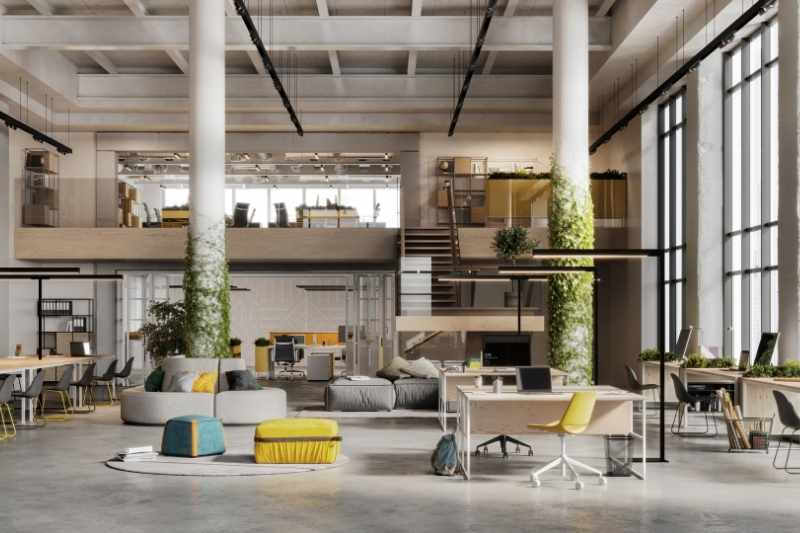
Now that people are accustomed to working from home, many employees are reluctant to return to the office. As a result, you must design your building’s office space to cater to tenants’ needs.
It’s your job to provide irresistible incentives to tenants so that they not only return to the office but also feel satisfied with their decision. The future of work requires you to reimagine the way you think about office space planning.
This guide covers the primary objectives you should focus on when planning your office space. It also includes office space planning guidelines and key strategies you can implement in your building.
This post will cover:
- What does office space planning mean?
- What are the objectives of office space planning?
- 3 ways to plan an office space
What does office space planning mean?
Office space planning is the act of organizing office space to best serve tenants and their employees. It involves arranging the office on a structural level, which includes the placement of rooms and furniture to increase employee efficiency.
In short, office space planning strives to optimize existing space for employees’ evolving needs. Not only does this boost their productivity, but it also enhances their overall office experiences, creating a sense of belongingness, safety, and inclusion.
Against the backdrop of the COVID-19 pandemic and the subsequent Great Resignation, commercial real estate professionals must rethink their old office designs to keep tenants and their employees in the office. And this involves redesigning and retrofitting existing spaces to meet new needs and safety measures.
What are the objectives of office space planning?
When office space planning, your primary objective is to offer a commercial office space that welcomes and comforts employees without compromising their productivity. Your second goal is to significantly improve their experience working in the office.
These days, people are used to working from home. As a result, employees are reluctant to return to the office because it doesn’t offer the same caliber of accommodations and flexibility their homes do. So, your office planning strategy should focus on improving physical comfort, increasing productivity, and fostering inclusivity.
Essential objectives for your office place planning checklist:
- Put employee well-being first: The office should make employees feel as happy and comfortable as they would feel at home.
- Revolutionize the tenant experience: Add amenities and services to the space that’ll entice employees to come to the office.
- Reduce operational costs: A highly efficient office costs less. With fewer employees coming to the office, consider reducing electricity, commodities, and office supplies.
- Enhance productivity: Address the flaws in the old office space layout, embracing what employees are looking for in a post-pandemic workspace.
- Provide a healthy environment: Ensure the office space is sanitary and health-conscious so that employees feel safe and comfortable during the workday.

3 ways to plan an office space
The best way to approach office space planning is first to lay out your key objectives, which you can gather from your office place planning checklist.
There are also three overarching strategies to consider before you start rearranging or purchasing furniture. These three points focus on return-to-office incentives.
3 steps to planning an office space:
1. Rethinking open floor plans
Before 2020, the open office floor plan was incredibly common and viewed by employers as the optimal workspace design. Executives and architects alike believed that open-floor offices increased employee engagement and did away with the stifling environment that came with cubicles.
However, as the Harvard Business Review points out, open floor plans have actually been proven to produce “less meaningful interactions, not more.” In one case, face-to-face interactions after migrating to an open floor plan dropped by 70%.
Being physically too close together can heighten anxiety in some employees. In a health-conscious society, this is especially true since most employees have grown accustomed to working from home and communicating electronically in an effort to practice social distancing.
Regardless, the open-floor office approach is gradually becoming a relic of the past.
So: How do I design an office layout — and what makes a good office layout?
When designing an office layout, you should focus on adding more private spaces throughout your building. You can do this by designating corners of your floor plan as working nooks and creating semi-private rooms. Employees should be able to work in a spot where they feel comfortable and won’t be disturbed.
Conversely, there should still be common areas within an office that allow employees to work collaboratively or in a more communal setting. These common areas should be separate from conference rooms so employees can freely talk amongst themselves.
How much space is required per person in an office?
It’s best to have between 100-200 usable square feet per person. The more, the merrier — if your building has ample space to dedicate to each person. Otherewise, you could always consider an office relocation.
Remember: Many employees will work flexible hours, with a portion of their time spent working from home. As such, your office space doesn’t need to accommodate every person employed by your tenant. Instead, you should plan the space for the average number of people in the office on a given workday.

2. Optimizing safety procedures
For many, the pandemic has created heightened levels of caution when being in a crowded, enclosed space. As a result, people have enhanced their health and safety protocols, such as washing their hands frequently and avoiding frequently touched surfaces.
As such, it’s paramount that you implement advanced safety and cleaning procedures in your office building. For the foreseeable future, employees will be extra cautious of spreading germs and viruses. Even if employees aren’t immunocompromised, they’ll feel a greater sense of relief if you can provide a clean and health-conscious work environment.
Safety strategies to include in your office space planning:
- A touchless office entry method. Install access control systems that allow tenants to open doors and navigate the building with their smartphones rather than using a physical key. The best systems also integrate with other app-controlled proptech devices, such as smart lights and thermostats.
- Hand sanitization stations. These should be stationed throughout the entire building — especially at entrances.
- Safety awareness signs. These can include reminders to wash your hands, clean devices after using them, and sanitize communal spaces after using them.
- Hire an in-house cleaning crew. Make sure they disinfect each office area frequently throughout the day.
Learn more about ButterflyMX for your commercial office:
3. Accommodating hybrid work schedules
The flex office is here to stay, so expect employees to have hybrid work schedules. As such, your office space planning must accommodate employees working both from the office and remotely.
Make sure your office space layout facilitates seamless communication between in-person and remote workers. Additionally, make the transition from different environments as smooth as possible.
Here are some tips for accommodating hybrid work schedules:
- Incorporate hybrid-friendly meeting rooms. These meeting rooms should be equipped with a large screen with a camera capable of connecting to a laptop for video-conferencing. Remember to also include a large conference table that can fit within the camera’s view. This setup will make remote employees feel included in meetings.
- Provide comfortable lounges. The best part about working from home is access to comfortable seating like a couch or a high-end desk chair. So, provide tenants with lounges not only in their offices but around the building in public spaces so that their employees can make themselves at home.
- Create “quiet” rooms in your building. Limiting distractions while working in the office is a major advantage. Be sure to include plenty of signage cautioning employees to keep the noise down around these rooms.
- Add a recreation room. Employees have plenty of fun things to do in their own homes. So, emulate that in the office by adding a rec room. Be sure to include games such as table tennis, billiards, and air hockey, as well as nooks for employees to play games of their own.
Takeaways
- Reimagining your office space planning is a great way to incentivize tenants and their employees to return to the office. To achieve this, add amenities and furniture that resemble those found in residential buildings. This way, employees can feel “at work” when working from the office.
- Do away with open floor plans. Tenants nowadays prioritize their privacy and should have the option to have quiet focus time. Studies show that closed floor plans lead to more productive engagement between coworkers.
- Sanitize communal spaces and high-touch points. Enforce safety procedures that reassure employees that their offices are clean and safe.
- Cater to hybrid workers by closing the experience gap between those working in-person and remotely.







